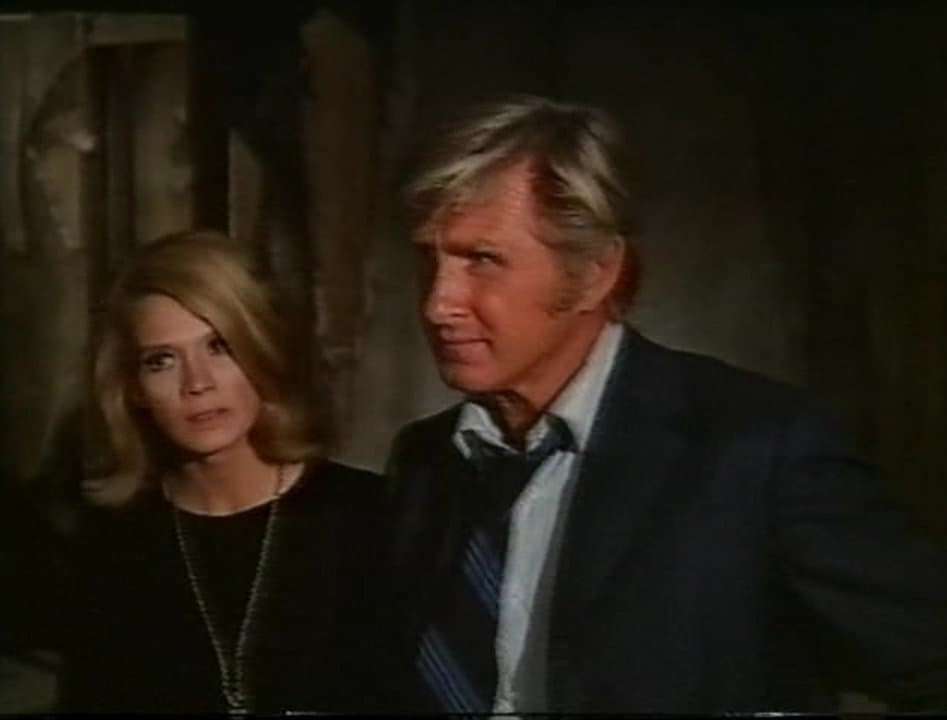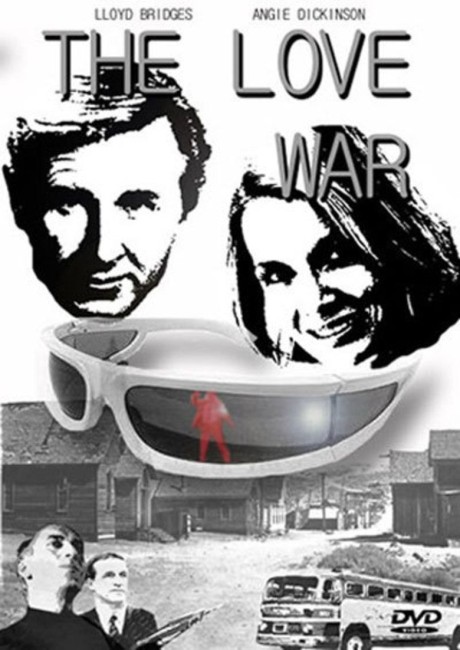Crew
Director – George McCowan, Teleplay – David Kidd & Guerdon Trueblood, Producer – Aaron Spelling, Photography – Paul Uhl, Music – Dominic Frontiere, Special Photographic Effects – Howard Anderson Co., Special Effects – Joe Lombardi, Art Direction – Tracy Bousman. Production Company – Aaron Spelling Productions, Inc.
Cast
Lloyd Bridges (Kyle), Angie Dickinson (Sandy), Dan Travanty [Daniel J. Travanti] (Todd), Harry Basch (Bal), Allen Jaffe (Hort)
Plot
Kyle pursues a man at L.A.’s Union Station and shoots him with a raygun. He then boards a bus to the tiny nowhere town on Piru near Fresno. Along the way, a woman Sandy boards the bus and comes to befriend Kyle even though he remains standoffish. As Kyle arrives in Piru, she on impulse jumps off and follows him. With her having no money, Kyle feels obliged to let her share his hotel room. There he tells her that he is an alien, a member of the Argon race. Earth is caught in the overlap between Argon and their rival Zinon and it has been mutually decided that each side will send three representatives to Earth to fight it out and the winning side will claim ownership of the Earth. He gives her a special pair of glasses that reveal his true self to her, although she faints at the sight. In the morning however, she refuses to leave and they both acknowledge an attraction. At the same time, Kyle’s Zinon pursuers arrive to hunt and eliminate him.
Producer Aaron Spelling was one of the most prolific television producers of all time. He masterminded shows such as Starsky and Hutch (1975-9), Fantasy Island (1976-84), The Love Boat (1977-86), Charlie’s Angels (1976-81), Dynasty (1981-9) and Beverly Hills 90210 (1990-2000). For a time during the early part of his career, Spelling made a number of horror tv movies with the likes of Crowhaven Farm (1970), How Awful About Allen (1970), The House That Would Not Die (1970), A Taste of Evil (1971), Satan’s School for Girls (1973) and Cruise Into Terror (1978) and the SF films The Last Child (1971) and A Cold Night’s Death (1973).
The Love War has a reasonable reputation from the era. It came after a decade that was filled with shows like The Twilight Zone (1959-63), The Outer Limits (1963-5) and The Invaders (1967-8), which were progressively turning the alien invader science-fiction of the 1950s inwards. You sneakingly suspect that the film here could easily have been condensed to work as an episode of The Outer Limits. Indeed, Star Trek (1966-9) had previously made a not dissimilar episode about representatives of rival alien species forced to fight it out on a planet with Arena (1966).
The film starts with an undeniable sense of mystery. Lloyd Bridges pursues a man through L.A.’s Union Station, using what look like Inuit snow goggles to locate him, then shoots him and departs as the body disintegrates in a red flame. This is followed by Bridges’ journey to the small real-life California town of Piru, his befriending Angie Dickinson on the way and explaining to her that he is an alien, about the war with the Zinon and giving her the goggles so that she can see his true form (something we never get to see until the last shot of the film), which causes her to faint.

The set-up has an intrigue, even if the script dabbles in some bad science-fiction – Lloyd Bridges keeps coming out with meaningless phrases like “Do you believe in infinity?” and “Infinity exists,” or the idea that Earth is caught in the ‘overlap’ between two other planets (whatever that might mean – the idea seems founded in the absurd notion that planets do not rotate in orbits). The film also draws on a certain anthrocentrism in science-fiction throughout this era – that any advanced civilisation would have abandoned feelings and emotions long ago and that all they need is to experience human love to reawaken this. Nevertheless, the skulking about and in particular the unusual relationship between the two leads holds the film together. The story arrives at a modestly effective and surprisingly downbeat twist ending (albeit one that the title sort of gives away).
The film has a fascinating cast. Lloyd Bridges, father of Jeff, was a seasoned actor who had gained great fame as the star of the hit tv series Sea Hunt (1958-61) and went on to a number of other films and tv roles, probably being most well known in later years for his role in Airplane!/Flying High (1980) and other comedies. This was also a time when Angie Dickinson was a hot and sexy talent. She had played a number of roles since the 1950s and was increasingly more known but was not a breakout name until the tv series Police Woman (1974-8) made her into a sex symbol of the era. Daniel J. Travanti, here billed only as Dan Travanty and playing one of the aliens, had played mostly tv bit parts since the 1960s and throughout most of the 1970s until he landed the lead role of Captain Frank Furillo in the hit tv series Hill Street Blues (1981-7), which netted him two Emmies as Best Actor.
George McCowan was a Canadian-born director who mostly worked in television. He had just made another non-science-fiction film for tv with The Challenge (1970) with a very similar plot about representatives of warring nations selected to fight it out. Although most of McCowan’s work was in tv, he had some success with the Nature’s Revenge film Frogs (1972) and went onto a couple of other Canadian-made genre films with Shadow of the Hawk (1976) about warring American Indian sorcerers and the space opera The Shape of Things to Come (1979).
Full film available here


